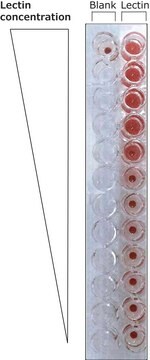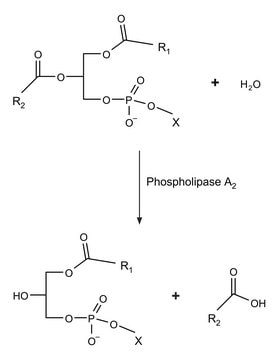P8804
Phospholipase C, Phosphatidylinositol-specific from Bacillus cereus
buffered aqueous glycerol solution, ≥1,000 units/mg protein (Lowry)
Sinónimos:
PC-PLC
About This Item
Productos recomendados
origen biológico
Bacillus sp. (Bacillus cereus)
Nivel de calidad
Formulario
buffered aqueous glycerol solution
actividad específica
≥1,000 units/mg protein (Lowry)
mol peso
28 kDa
actividad extraña
Phopholipase C (lecithinase) ≤1 units/mg protein
Sphingomyelinase ≤40 units/mg protein
temp. de almacenamiento
2-8°C
Información sobre el gen
Bacillus cereus E33L ... BCZK3513(3026815)
¿Está buscando productos similares? Visita Guía de comparación de productos
Descripción general
Aplicación
- in the hydrolysis of substrates p-nitrophenylphosphorylcholine (p-NPPC) and p-nitrophenylphosphorylphosphate (p-NPP)
- to cleave glycosylphosphatidylinositol (GPI) anchor of lynx1 protein and its detachment from plasma membrane
- to cleave immunolabeled HeLa cells
Acciones bioquímicas o fisiológicas
Definición de unidad
Forma física
Nota de análisis
Inhibidor
Código de clase de almacenamiento
11 - Combustible Solids
Clase de riesgo para el agua (WGK)
WGK 3
Punto de inflamabilidad (°F)
Not applicable
Punto de inflamabilidad (°C)
Not applicable
Equipo de protección personal
Eyeshields, Gloves, type N95 (US)
Elija entre una de las versiones más recientes:
¿Ya tiene este producto?
Encuentre la documentación para los productos que ha comprado recientemente en la Biblioteca de documentos.
Los clientes también vieron
Artículos
GPI Anchored Glycoproteins
Nuestro equipo de científicos tiene experiencia en todas las áreas de investigación: Ciencias de la vida, Ciencia de los materiales, Síntesis química, Cromatografía, Analítica y muchas otras.
Póngase en contacto con el Servicio técnico












